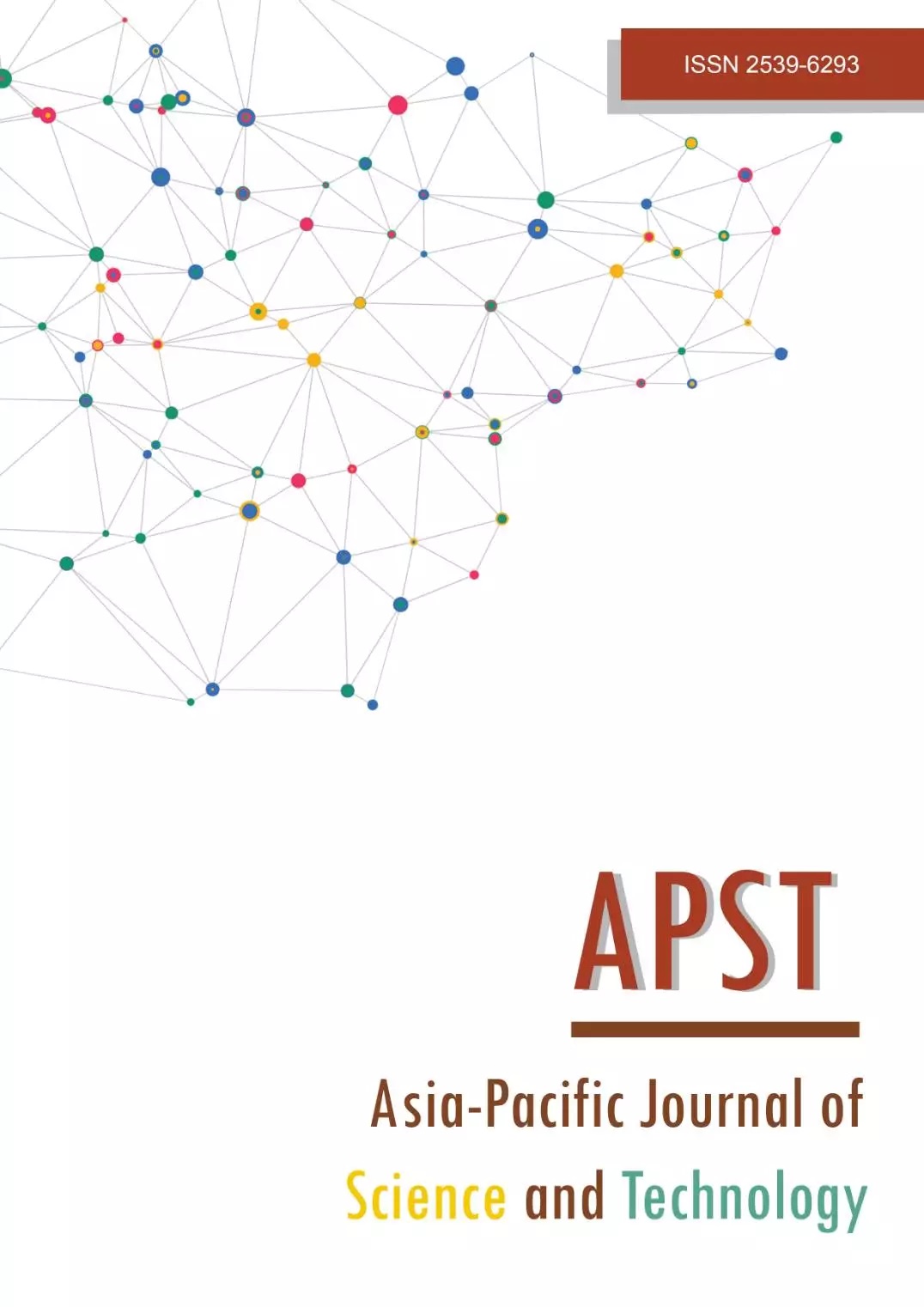Investigation of mangosteen 1H-NMR relaxation properties aims for detection of translucent flesh disorder
Main Article Content
Abstract
Nuclear magnetic resonance (NMR) relaxation properties of four separate mangosteen tissues—normal flesh, translucent flesh, pericarp, and seed—were investigated to assess the potential application of NMR relaxometry in detecting translucent flesh disorder. Longitudinal and transverse relaxation signals from each tissue type of the tested mangosteens were collected using the inversion recovery (IR) and Carr–Purcell–Meiboom–Gill (CPMG) pulse sequences, respectively. Longitudinal relaxation time constant (T1) spectra and transverse relaxation time constant (T2) spectra of the four tissues were obtained using the free inverse Laplace transform software CONTIN. Analysis of the T1 vs. T2 distribution of the major peaks of the spectra revealed that the clusters of the normal flesh and translucent flesh were isolated, whereas the clusters of seed and pericarp tissue mostly overlapped. Clusters of normal and translucent flesh were distinguished via T2 relaxation time at approximately 0.66 s at 21 MHz. Moreover, the NMR signal intensities of seed and pericarp were significantly lower than those of normal and translucent flesh. This technique may be usefully applied in detection of translucent flesh. However, detection of translucent flesh via T2 relaxation time should be further verified in intact mangosteens before the approach sees practical application.
Article Details

This work is licensed under a Creative Commons Attribution-NonCommercial-NoDerivatives 4.0 International License.
References
Pankasemsuk T, Garner JO, Matta FB, Silva JL. Translucent flesh disorder of mangosteen fruit (Garcinia mangostana L.). Hort Sci. 1996;31(1):112-113.
Nakawajana N, Terdwongworakul A, Teerachaichayut S. Minimally destructive assessment of mangosteen translucency based on electrical impedance measurements. J Food Eng. 2016;171:137-144.
Jaritngam R, Limsakul C, Wongkittiserksa B. The relation between the texture properties of mangosteen (Garcinia mangostana Linn.) And the resonance frequency in detection of the translucent and yellow gummy latex. Emirates J Food Agric. 2013;25:89-96.
Tongleam T, Jittiwarangkul N, Kumhom P, Chamnongthai K. Non-destructive grading of mangosteen by using microwave moisture sensing. In: Itoh Y, Dejhan K, editors. International Symposium on Communications and Information Technology (ISCIT); 2004 Oct 26-29; Sapporo, Japan. New York: IEEE; 2004. p. 650-653.
Teerachaichayut S, Kil KY, Terdwongworakul A, Thanapase W, Nakanishi Y. Non-destructive prediction of translucent flesh disorder in intact mangosteen by short wavelength near infrared spectroscopy. Postharvest Biol Tech. 2007;43(2):202-206.
Yantarasri T, Sornsrivichai J, Chen P. X-ray and NMR for nondestructive internal quality evaluation of durian and mangosteen fruits. In: Bieleski R, Liang W, Clark, editors. International Postharvest Science Conference Postharvest 96; 1998 Mar 1; Taupo, New Zeland. Leuven: ISHS; 1998. p. 97-102.
Terdwongworakul A, Nakawajana N, Teerachaichayut S, Janhiran A. Determination of translucent content in mangosteen by means of near infrared transmittance. J Food Eng. 2012;109(1):114-119.
Colnago LA, Wiesman Z, Pages G, Musse M, Monaretto T, Windt CW, et al. Low field, time domain NMR in the agriculture and agrifood sectors: an overview of applications in plants, foods and biofuels. J Magn Reson. 2021;323:106899.
Rudszuck T, Förster E, Nirschl H, Guthausen G. Low-field NMR for quality control on oils. Magn Reson Chem. 2019;57(10):777-793.
Snaar JEM, Van As H. Probing water compartments and membrane permeability in plant cells by 1H NMR relaxation measurements. Biophys J. 1992;63(6):1654-1658.
Hills BP. Applications of low-field NMR to food science. In: Webb GA, editor. Annual reports on NMR spectroscopy. 58th ed. Massachusetts: Academic Press; 2006. p. 177-230.
Berman P, Levi O, Parmet Y, Saunders M, Wiesman Z. Laplace Inversion of low-resolution NMR relaxometry data using sparse representation methods. Concepts Magn Reson Part A Bridg Educ Res. 2013;42(3):72-88.
Joardder MUH, Kumar C, Karim MA. Food structure: its formation and relationships with other properties. Crit Rev Food Sci Nutr. 2017;57(6):1190-1205.
Khan MIH, Wellard RM, Nagy SA, Joardder MUH, Karim MA. Investigation of bound and free water in plant-based food material using NMR T2 relaxometry. Innov Food Sci Emerg Technol. 2016;38:252-261.
Paopun Y, Umrung P, Thanomchat P. Cell wall structure of translucent cells of mangosteen fruit. In: Poovarodom S, Yingjajaval S, ediors.VII International Symposium on Mineral Nutrition of Fruit Crops; 2013 May 19; Chanthaburi, Thailand. Leuven: ISHS; 2013. p. 421-426.
Mao R, Tang J, Swanson BG. Relaxation time spectrum of hydrogels by CONTIN analysis. J Food Sci. 2000;65:374-381.
Provencher SW. CONTIN: a general purpose constrained regularization program for inverting noisy linear algebraic and integral equations. Comput Phys Commun. 1982;27(3):229-242.
Brownstein KR, Tarr CE. Importance of classical diffusion in NMR studies of water in biological cells. Phys Rev A.1979;19(6):2446-2453.

